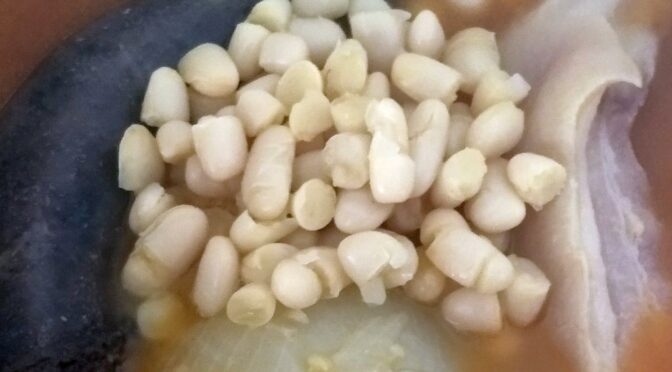Fabada Asturiana is a traditional dish from the region of Asturias in northern Spain. It’s a hearty and satisfying stew made with white beans, chorizo sausage, and other meats, and it’s often enjoyed with crusty bread and cider, which is another Asturian specialty. You can often find Fabada Asturiana on menus in Rondas restaurants.
The dish has its roots in the rural communities of Asturias, where it was a popular meal for farmers and shepherds who needed a nourishing and filling meal to sustain them through long days of work. The combination of white beans and meats was also a practical one, as it made use of the ingredients that were readily available in the region.
Fabada Asturiana has since become a beloved dish throughout Spain and beyond, and it’s often served at family gatherings and special occasions. In fact, there’s a saying in Asturias that goes “de la fabada a la sidra, la tripa llena y el corazón contento” (“from fabada to cider, a full stomach and a happy heart”), which speaks to the joy and comfort that this dish brings to those who enjoy it.
An interesting anecdote about Fabada Asturiana is that it’s so popular that it even has its own festival in Asturias! The Festival of the Bean Stew, or Festival de la Fabada, takes place every year in the town of Villaviciosa, and it attracts thousands of visitors who come to taste the best versions of this delicious dish.
Here’s the recipe for Fabada Asturiana in both metric and imperial units
Ingredients:
- 500g (1 lb) dried white beans (such as Faba Asturiana or cannellini beans)
- 500g (1 lb) chorizo sausage
- 250g (1/2 lb) smoked ham or pork belly, diced
- 1 large onion, chopped
- 4 cloves garlic, minced
- 2 bay leaves
- 1 teaspoon sweet paprika
- 1/4 teaspoon saffron threads
- 2 teaspoons salt
- Water
- Olive oil
For serving:
- Crusty bread
- Cider (traditional drink of Asturias)
Instructions:
- Rinse the beans and soak them in cold water overnight.
- The next day, drain the beans and place them in a large pot. Add enough water to cover the beans by about 2 inches. Bring the water to a boil over high heat, then reduce the heat to low and simmer for 1-2 hours, until the beans are tender. Skim off any foam that rises to the surface of the pot while the beans are cooking.
- While the beans are cooking, slice the chorizo into rounds. Heat a drizzle of olive oil in a frying pan over medium heat and add the chorizo. Cook until browned on both sides, then transfer to a plate.
- In the same frying pan, add the diced ham or pork belly and cook until browned. Transfer to the plate with the chorizo.
- In the same frying pan, sauté the chopped onion and minced garlic until softened and lightly browned. Add the sweet paprika and saffron and cook for another minute.
- Add the cooked chorizo and ham/pork belly to the pot with the beans, along with the sautéed onion and garlic mixture, bay leaves, and salt. Add enough water to cover the beans by about 1 inch.
- Bring the pot to a simmer and cook for another 30-40 minutes, until the flavors have melded together and the stew has thickened slightly. Stir occasionally and add more water if necessary to keep the stew from getting too thick.
- Taste the stew and adjust the seasoning as needed. Remove the bay leaves and discard.
- Serve the Fabada Asturiana hot, with crusty bread and cider on the side. Enjoy!
Here are some tips and tricks for making Fabada Asturiana:
- Soak the beans overnight to ensure they cook evenly and thoroughly.
- Skim off any foam that rises to the surface of the pot while the beans are cooking, as this can give the stew a bitter taste.
- Brown the chorizo and ham/pork belly in a frying pan before adding them to the stew. This will give them a crispy texture and add extra flavor to the dish.
- Sauté the onions and garlic in the same frying pan that you used to brown the meats, as this will help to infuse the stew with their flavors.
- Use high-quality ingredients, such as Faba Asturiana beans and authentic Spanish chorizo, for the best results.
- Adjust the seasoning to your taste, as the amount of salt and spices needed may vary depending on the ingredients and your personal preferences.
- Serve the Fabada Asturiana hot, with crusty bread and cider on the side, for a truly authentic and delicious experience.
Ronda Today
Everything you need to know before you visit Ronda “The city of dreams” in Andalucia. https://www.rondatoday.com/
Wildside Holidays – Spain
Take a trip on the Wildside! Discover the wildlife and nature of Spain, its Natural and National Parks and find the top wildlife, activity and walking holiday companies.
Iberia Nature Forum
Struggling with identifying those bugs and beasties? Why not check out the Iberia nature Forum!
Discover the Iberia Nature Forum – Environment, geography, nature, landscape, climate, culture, history, rural tourism and travel.
I’ve been living in this lovely area of Western Andalucia for the last 20 years or so and dedicate most of my time to the running of English language tourist information websites for the towns of Cádiz, Ronda, Grazalema, the famous or infamous Caminito del Rey, and also Wildside Holidays, which promotes sustainable and eco-friendly businesses running wildlife and walking holidays in Spain.




